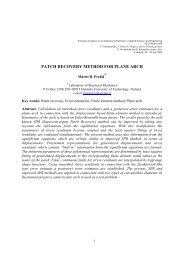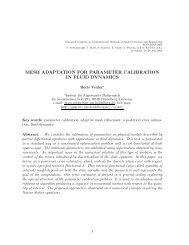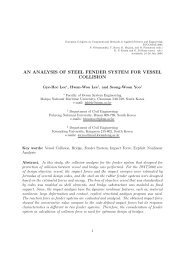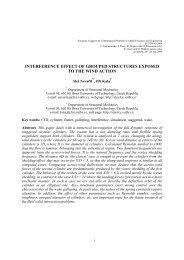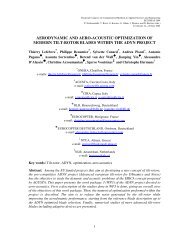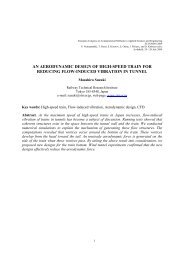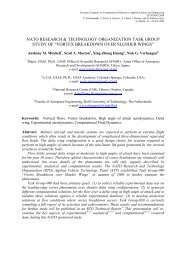Aerodynamic Design of Unmanned and Scaled Supersonic ...
Aerodynamic Design of Unmanned and Scaled Supersonic ...
Aerodynamic Design of Unmanned and Scaled Supersonic ...
Create successful ePaper yourself
Turn your PDF publications into a flip-book with our unique Google optimized e-Paper software.
K. Yoshida <strong>and</strong> Y. Makino<br />
pressure distribution to delay transition satisfying the conditions mentioned above.<br />
Therefore, as an approximation, we adjusted the maximum thickness <strong>of</strong> the modified wing<br />
geometry to the prescribed maximum thickness at the smoothing process by CATIA. The “3rd<br />
Configuration” was designed after six iterations even though no complete convergence was<br />
obtained. However, desirable transition characteristics were not obtained using the SALLY<br />
code. The main reason was originated in the resolution <strong>of</strong> CFD analysis near the leading edge.<br />
Therefore, in the re-design phase, the resolution was improved to realize the pressure gradient<br />
almost same as that <strong>of</strong> the target one in accelerated region. Furthermore, we kept the<br />
prescribed thickness ratio at outboard wing because <strong>of</strong> severe structural design requirements.<br />
However, we did not adjust the maximum thickness <strong>of</strong> the modified geometry at inboard wing<br />
to approach the convergence. Finally, we selected the modified wing configuration after ten<br />
iterations as the “4th Configuration”. Consequently, the “4th Configuration” had the<br />
improvement <strong>of</strong> the pressure gradient near leading edge as we already expected. The<br />
transition analysis <strong>of</strong> the “4th Configuration” by the SALLY code indicated desirable<br />
transition characteristics.<br />
The wing section geometry <strong>of</strong> the “4th Configuration” was shown in Figure 8 <strong>and</strong> its<br />
spanwise thickness ratio distribution was also shown in Figure 5. No adjustment <strong>of</strong> its<br />
maximum thickness to the prescribed one was reflected in thicker distribution at inboard wing<br />
region. And this led to a remarkable deviation from the exact supersonic area distribution due<br />
to the Sears-Haack body. Naturally, it meant an<br />
increase <strong>of</strong> wave drag due to volume. However, we<br />
recognized the validation <strong>of</strong> the NLF wing concept<br />
was more valuable than the validation <strong>of</strong> high L/D<br />
in flight test.<br />
The SALLY code is formulated in the<br />
framework <strong>of</strong> incompressible stability theory.<br />
Therefore, in the analysis <strong>of</strong> the supersonic NLF<br />
wing, we can not predict transition location<br />
quantitatively, including little database for<br />
transition criteria on the so-called N value.<br />
Furthermore, any codes based on compressible<br />
stability theory are not available in Japan.<br />
Therefore, at least, to solve the formulation<br />
problem, we developed an original<br />
compressible e N code, which was called<br />
LSTAB code [13]. And we also tried to<br />
develop a reliable transition database on the<br />
critical N value for onset <strong>of</strong> transition in<br />
supersonic flow.<br />
Transition characteristics <strong>of</strong> the “4th<br />
Configuration” were estimated using the<br />
LSTAB code as shown in Figures 9. Here we<br />
assumed N=14 as the criterion <strong>of</strong> transition,<br />
Y/L<br />
0.0<br />
-0.1<br />
8*z/l<br />
8*(z/L)<br />
0<br />
-0.01<br />
-0.02<br />
-0.03<br />
NEXST-1: NLF Wing<br />
0.3 0.4 0.5 0.6 0.7 x/L<br />
x/l<br />
Figure 8. <strong>Design</strong>ed NLF Wing Geometry<br />
M=2.0, H=15km, N TR. =14<br />
-0.2<br />
α=0.0°<br />
α=1.0°<br />
α=1.5°<br />
-0.3 α=2.0°<br />
α=2.5°<br />
α=3.0°<br />
DP<br />
-0.4<br />
Estimated turbulent region<br />
HF<br />
TC influenced Cp(UPACS: by AS2-grid, the attachmentline<br />
LBL(Kaups-Cebeci), contaminationLSTAB(Path B)<br />
X/L<br />
TBL condition),<br />
Preston<br />
-0.5<br />
0.0 0.1 0.2 0.3 0.4 0.5 0.6 0.7 0.8 0.9 1.0<br />
Figure 9. Estimated transition locations at H=15km<br />
9



